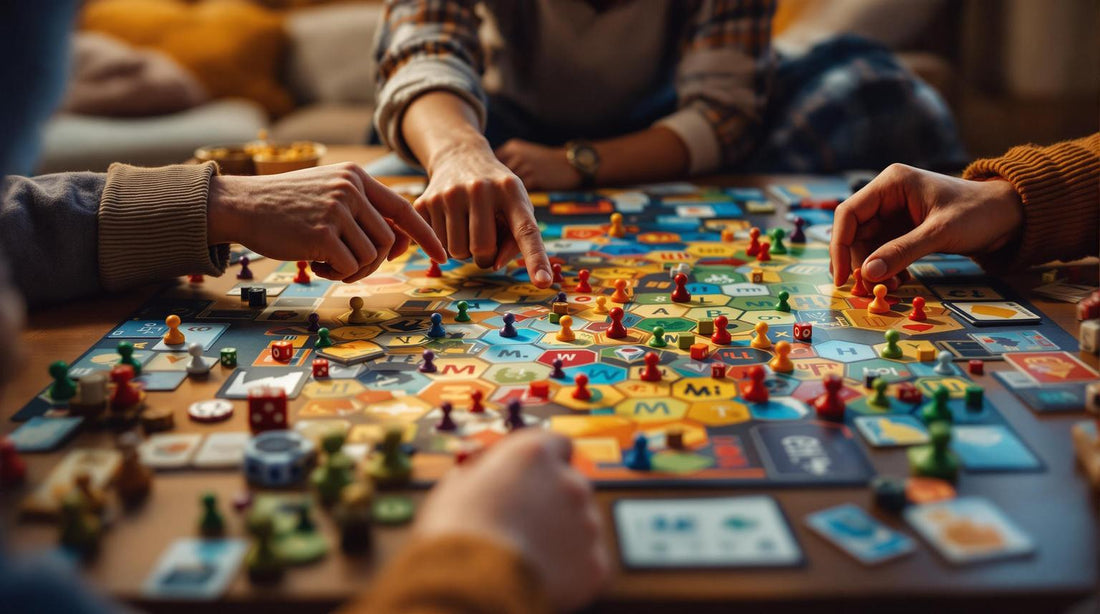Discover the Best Board Games for Every Player

How to Balance Cooperation and Competition in Games
Balancing cooperation and competition in games creates a more engaging experience by combining teamwork with individual goals. Games like Pandemic focus on shared objectives, while 7 Wonders mixes collaboration with personal strategies. To achieve this balance, consider:
- Mechanics: Ensure actions impact both group and individual progress.
- Player Interaction: Foster collaboration without overshadowing competition.
- Fairness: Make competitive elements satisfying and equitable.
- Replayability: Blend dynamics to keep gameplay fresh and varied.
Quick Overview:
- Cooperative Games: Shared goals, teamwork, and minimal conflict (e.g., Pandemic).
- Competitive Games: Individual achievements, strategic rivalries (e.g., Ticket to Ride).
- Hybrid Games: Mix of alliances and personal objectives (e.g., Root).
| Feature | Cooperative Games | Competitive Games | Hybrid Games |
|---|---|---|---|
| Goal | Team victory | Individual success | Both shared and personal |
| Interaction | Collaboration | Rivalry | Dynamic alliances |
| Replay Value | Predictable once mastered | Player-driven variability | Balanced dynamics |
To create the right mix, test mechanics, observe player behavior, and adjust based on feedback. Focus on shared challenges, resource management, and balanced rewards to keep the game engaging for all players.
Core Concepts: Cooperation vs Competition
What Makes Games Cooperative or Competitive
The way games are designed - whether cooperative or competitive - affects how players interact and work toward objectives. In cooperative games, players join forces to achieve shared goals, combining their resources and abilities. Take Forbidden Desert (2013), for example: players team up to find artifacts and escape, each using their unique roles to contribute to the mission.
On the other hand, competitive games encourage players to focus on individual victories. Ticket to Ride is a great example, where players race to claim routes and complete objectives. The game's mechanics often push players to choose between blocking opponents' plans or advancing their own strategy.
Pros and Cons of Each Style
Each style has its own strengths and challenges, shaping the overall gaming experience:
| Aspect | Cooperative Games | Competitive Games |
|---|---|---|
| Player Engagement | Encourages teamwork and shared accomplishments | Rewards individual success and personal goals |
| Social Dynamics | Fosters collaboration and minimizes conflicts | Creates rivalries and tests strategic thinking |
| Replay Value | Can feel repetitive once mastered | Stays dynamic due to player-driven variability |
| Learning Curve | Easier for beginners to pick up | Might be challenging for new players |
| Player Elimination | Rarely present | Common, which can leave some players sidelined |
Finding the Right Mix
Some of the most engaging games skillfully combine cooperative and competitive elements. Root (2018) is a standout example, where players compete for victory but can form temporary alliances when it suits their goals.
The secret to a successful blend lies in features like shared threats, resource trading, dynamic alliances, and flexible victory conditions. Cosmic Encounter (1977) is another classic example, allowing players to invite others to join them in attacks or defenses. This creates ever-changing alliances and forces players to balance their personal goals with group dynamics. The constant tension between individual gains and collective benefits keeps decisions meaningful and the gameplay engaging.
Next, we’ll explore how to analyze these dynamics by examining game mechanics and player behavior.
Measuring Game Dynamics
Listing Game Elements
Start by breaking down the main components of the game - like scoring systems, player interactions, and how resources are handled. This helps you spot whether the game leans more toward teamwork or competition. For example, in Pandemic (2008), the shared goal of winning as a team and the use of a collective resource pool emphasize teamwork. At the same time, each player's unique abilities add an element of individual strategy.
Here’s a quick breakdown of what to look for:
| Game Feature | Cooperative Indicators | Competitive Indicators |
|---|---|---|
| Victory Conditions | Goals achieved as a team | Focus on individual accomplishments |
| Resource Management | Shared resource pools | Separate, personal resources |
| Player Actions | Moves that benefit the group | Moves aimed at personal advantage |
| Information Sharing | Open communication and transparency | Hidden or restricted information |
| Conflict Resolution | Group decisions | One-on-one confrontations |
Once you’ve identified these elements, pay attention to how they shape the way players interact during the game.
Reading Player Behavior
Watch how players communicate and make decisions to understand the balance between working together and competing. Are players thinking about the group’s success, or are they mainly focused on their own goals? Games like Betrayal at House on the Hill (2004) offer a great example of this shift. Players start by working together, but as the game progresses, they may need to turn against each other, which reveals how these dynamics evolve.
Finding Problem Areas
Use your observations to spot where the game might become unbalanced. Look for signs that could disrupt the experience, such as:
- Players focusing too much on personal benefits
- Strategies that dominate and leave little room for creativity
- Limited interaction between players
- Players being eliminated early in the game
- Certain players having too much control over the outcome
Pay attention to things like how much players are talking, how quickly decisions are being made, and how often resources are exchanged. These clues can help you pinpoint specific issues. Don’t forget to gather direct feedback from players - they can provide valuable insights to ensure any changes address real problems, not just surface-level impressions.
What Are the Key Differences Between Competitive and Cooperative Game Strategies?
sbb-itb-1ed942f
Building Better Cooperation
Use these tips to create mechanics that encourage teamwork naturally.
Group Goals and Resources
Design shared objectives that require contributions from all players. Introduce a communal resource pool - like cards, tokens, or action points - that players must manage together. This setup sparks discussions about strategy and resource use.
Key features of group goals include:
- Victory conditions that can only be reached through teamwork
- Interdependent roles with unique abilities for each player
- Resource systems that encourage sharing and collaboration
- Mechanics that reward cooperative choices
Team-Based Game Rules
Translate shared goals into rules that encourage teamwork without making it mandatory. Focus on mechanics that reward players for choosing to collaborate.
Here’s how various mechanics can support teamwork:
| Mechanic | Implementation | Benefit |
|---|---|---|
| Action Sharing | Allow players to share actions | Promotes strategic planning |
| Information Exchange | Use limited communication rules | Builds interdependence |
| Synergy Bonuses | Combine abilities for bonuses | Encourages coordination |
| Threat Management | Introduce shared challenges | Requires joint problem-solving |
Group Planning Elements
Take cooperative rules further by adding chances for group planning. These could include:
- Coordinating turns to align strategies
- Assessing threats as a team
- Voting on critical decisions
- Setting timed discussion phases
Integrate planning elements that keep the game engaging while boosting collaboration.
Making Competition Work
Design competition in a way that complements cooperation. A well-thought-out competitive framework can highlight individual efforts while still encouraging teamwork.
Personal vs. Team Success
Set up systems that reward both individual achievements and team accomplishments. This ensures that personal contributions are recognized, but group success remains a priority.
| Success Type | Reward Structure | Example |
|---|---|---|
| Individual | Points for personal tasks | Earn 2 points for completing individual objectives |
| Team-based | Bonuses for shared goals | Team earns 5 bonus points for group milestones |
| Hybrid | Points multiplier | Personal points increase based on team performance |
| Balanced | Split rewards | 50% of points go to personal score, 50% to team total |
For example, completing a personal task could unlock a bonus that benefits the entire team, reinforcing the connection between individual and group success.
Equal Opportunities for Players
Design mechanics that give every player meaningful choices, ensuring no one dominates early on while keeping the competition engaging.
Here are some ways to maintain fairness:
- Use catch-up mechanisms that help trailing players without feeling forced.
- Distribute power roles evenly across different phases of the game.
- Offer multiple paths to victory to suit various playstyles.
- Include shared decision-making moments where all players have input.
Balancing Luck and Skill
Introduce controlled random elements to create opportunities for newer players while keeping the focus on skill. The goal is to strike a balance that rewards strategy but still leaves room for surprises.
- Use randomness players can influence through smart decisions.
- Provide layers of strategy to cater to different experience levels.
- Add mechanics that adjust the challenge based on player actions.
The ideal mix of luck and skill depends on your audience and game type. Experiment with different setups and gather feedback from varied player groups to find the right balance for your game.
Testing and Adjusting Balance
Fine-tuning the balance between cooperation and competition in a game requires careful testing and feedback.
Getting Player Input
Organize playtests to gather specific feedback about how players experience cooperative and competitive elements. Observe their behavior and take note of their reactions.
| Feedback Area | Key Questions | What to Watch For |
|---|---|---|
| Cooperative Elements | Did you feel there were enough chances to work together? | Players helping or ignoring teammates |
| Competitive Balance | Were individual achievements satisfying? | Frustration or disengagement |
| Overall Experience | Did your actions influence the outcome? | Player enthusiasm and interest in replaying |
Making Small Changes
Start with the most common feedback and make adjustments gradually.
1. Document Current State
Record how the game currently balances cooperation and competition. Identify which mechanics encourage positive interactions and which may cause friction.
2. Test Single Variables
Change one element at a time during each playtest to isolate its effects.
3. Measure Impact
Evaluate how the change influences player satisfaction and group dynamics. Look for signs of increased engagement and reduced negative feedback.
This step-by-step approach ensures the game maintains its balance while addressing issues.
Keeping Games Fresh
Introduce controlled variations to keep the game engaging while preserving its core dynamics.
Here are some ways to mix things up:
- Rotate player roles or special abilities in each session.
- Offer optional rule tweaks for more experienced players.
- Add environmental challenges that require new teamwork strategies.
- Implement milestone-based challenges that open up new competitive opportunities.
These updates encourage players to rethink their strategies without disrupting the cooperative and competitive balance.
Conclusion
Designing board games that balance cooperation and competition requires a deep understanding of how players interact. The goal is to mix teamwork with individual achievements while steering clear of mechanics that could disrupt the fun.
Take inspiration from titles like Flow and Karakum by Brain Games. Flow highlights shared goals that encourage problem-solving together, while Karakum cleverly weaves in competitive aspects without losing the social enjoyment.
Here are a few tips to guide your design process:
- Watch Player Interactions: Pay attention to how players respond to both cooperative and competitive elements.
- Test Changes Gradually: Tweak one aspect at a time to see how it affects gameplay.
- Offer Adjustable Options: Provide ways to modify difficulty or competition levels to suit different groups.
The best games create moments where competition supports, rather than detracts from, teamwork. Regular playtesting helps ensure your game strikes that balance and appeals to a wide range of players.
For more ideas, check out Brain Games' collection of family, party, and strategy games - they showcase various ways to combine cooperative and competitive elements for a fun, engaging experience.






